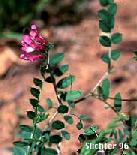
American Vetch
Vicia americana Muhl. ex Wild.
var oregana Nutt.

American Vetch
Vicia americana Muhl. ex Wild.
var oregana
Nutt.
This delicate vine with intensely with 2 to 6 bluish-purple flowers on stalks that originate from the axils of leaves. Leaves are pinnately compound, with terminal leaflets developed into tendrils that wrap around solid objects and support plant in an upright position. Stems are slender, square, and 1-4 feet long. It puts on a solo performance as it often flowers after the showy displays of our spring wildflowers. The vetch flower is typical of the papilionoid subfamily of legumes. The two lower petals in each flower are fused into a keel. The two lateral petals are called wings. The broad uppermost petal is called the banner. The stamens and pistil are obscured by the folded keel. Most common in moist or sheltered foothill canyons or in brush or meadowlands at middle mountain elevations; ascending form juniper-sagebrush through oak-mountain mahogany and ponderosa pine forests into the fir-aspen community, and coming out onto clay banks and stony hilltops in valley badlands. It is frequent throughout the Intermountain region.
Caution: The American Vetch is a Poisonous Plant. It contains toxic alkaloids and amino acids that affect the nervous system. Eating can cause headaches, dizziness, fever, or even death in some cases.
Value for Wildlife:
American vetch provides excellent forage for livestock and wildlife. Mule
deer, black bear, and grizzly bear browse the leaves and flowers. American vetch
also provides forage for game birds and small mammals